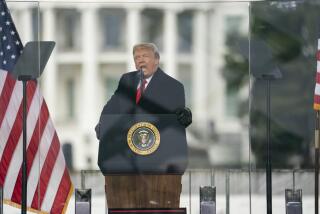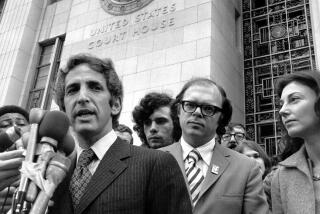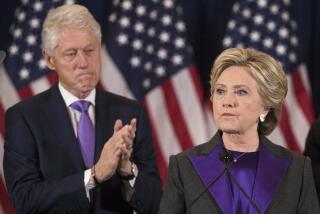Watergate Break-In Ignited Biggest Political Scandal in U.S. History
WASHINGTON — In all of American history there never was a political scandal like it. All the elements were there, from penny-ante dirty tricks--charging $200 worth of pizza to political opponents--to corruption at the highest level of the government, a president committing impeachable crimes.
The scandal known as Watergate, after the building in which it began, launched a trend in the tagging of far lesser official mis-
deeds: Koreagate, Travelgate, Iran-
gate and Filegate.
Watergate started on June 17, 1972, as a Keystone Kops caper. Five men dressed in suits and ties were surprised in the act of rifling the office of the Democratic National Committee, their hands sheathed in surgical gloves and their pockets stuffed with sequentially numbered $100 bills.
It climaxed with the Aug. 9, 1974, resignation in disgrace of Republican Richard M. Nixon from the highest office in the land, prison terms for 25 men, and a distrust of government that never dissipated.
Strangely, 25 years later nobody is sure what the burglars were looking for. What is known is they were attempting to repair a telephone bug they had installed three weeks before, and they were rifling through files, photographing some.
Watergate had many faces but at the core it was a subversion of the Constitution by the president who had sworn to protect it. The lawbreaking oozed through the White House to functionaries inside and outside the administration. Men who entered government with a zeal to serve the people ended up serving prison time instead. This was a men’s scandal; women were largely absent.
Watergate began with money, but that wasn’t its evil. “No man or no woman came into this administration and left it with more of this world’s goods than when he came in,” Nixon said just before he boarded the helicopter that started his journey to exile.
He was right. Underlying Watergate was the arrogance of power and the desire to hang onto it at all costs. The surprise was that so many were willing to sacrifice principle on that altar.
If it meant breaking the law or “stonewalling”--one of the terms popularized during Watergate--it was done. If it meant lies or bribery or coercion, so be it. If it meant turning on a friend to fashion a sacrificial lamb, too bad.
Nixon, the 37th president of the United States, was deemed by a grand jury to be a co-conspirator. But he escaped impeachment by resigning and avoided indictment through a pardon. His successor, Gerald Ford, felt the country had endured enough--and that sentiment may have cost him the presidency in the 1976 election, when Jimmy Carter won with a promise to the American people that he would never lie to them.
*
The burglars could have been assembled by a novelist.
They worked under the direction of G. Gordon Liddy, a former FBI man and White House operative who by then was finance counsel at Nixon’s Committee for the Re-election of the President, commonly known as CREEP. Liddy had grandiose schemes for an espionage operation, including use of prostitutes, bugging telephones, mugging opponents and kidnappings. He wanted $1 million for it; he got $250,000.
His top aide was E. Howard Hunt, a former CIA spy who had participated in the failed Bay of Pigs invasion and who had already written 42 spy novels.
Four of the burglars were part of Miami’s Cuban exile community and veterans of that invasion. They became known collectively as “the Cubans,” although one of them--Frank Sturgis--was not Cuban. The fifth burglar, James W. McCord, a 20-year CIA technician, was in charge of CREEP’s security.
Investigators quickly established their connection to the president’s reelection committee. The FBI traced the $100 bills to $89,000 in CREEP money deposited in one burglar’s bank account via a Mexican connection.
Throughout all of this, there were official denials of involvement from the White House--where press secretary Ron Ziegler called the affair “a third-rate burglary”--and from former Atty. Gen. John Mitchell, who headed the reelection committee.
“I had no prior knowledge of the Watergate break-in,” Nixon told the nation in a speech Aug. 15, 1973. “I neither took part in nor knew about any of the subsequent cover-up activities; I neither authorized nor encouraged subordinates to engage in illegal or improper campaign tactics. That was and is the simple truth.”
*
But it wasn’t simple, and it wasn’t truth.
Only six days after the break-in, on June 23, 1972, Nixon had assented to a plan suggested by chief of staff H.R. Haldeman to derail the FBI’s investigation by claiming that it would interfere with a CIA operation. This conversation, when it became public, was the final straw in persuading Nixon to resign two years later.
The cover-up was brought on--indirectly, if not directly--by Nixon’s paranoia that he could lose his reelection effort to Democratic Sen. George McGovern of South Dakota. Nixon could not foresee his landslide victory; only Massachusetts and the District of Columbia went for McGovern.
From that flowed CREEP’s dirty tricks department, which included such activities as circulating “endorsements” of McGovern by blacks in predominantly white neighborhoods; ordering $300 worth of booze and $200 worth of pizzas sent to a Democratic fund-raiser and sticking the Democrats with the bill; stationing hecklers at McGovern rallies.
Then came the Watergate burglary, part of an intelligence plan that spy buff Liddy called “Gemstone.”
Washington Post reporter Bob Woodward was there when the burglars appeared in court the day of the break-in. He heard McCord whisper “CIA” when the men were asked to identify themselves. That started him and colleague Carl Bernstein on an investigation that won them a Pulitzer Prize.
The election came and went. Watergate was not a factor in the outcome.
That winter, the cover-up went into high gear.
On the January 1973 morning when their trial was to start, Hunt and the Cubans pleaded guilty in U.S. District Court to conspiracy, burglary and wiretapping. Liddy and McCord chose to stand trial and were convicted of the same charges.
Hunt demanded clemency and money to buy his henchmen’s continued silence. It finally got to the point where White House counsel John Dean went to Nixon on March 21, 1973, to tell him: “We have a cancer within--close to the presidency--that’s growing. It’s growing daily. It’s compounding. . . . We’re being blackmailed; people are going to start perjuring themselves very quickly.”
Dean implicated numerous high-level White House staffers: Haldeman had wanted a political intelligence operation; Liddy was picked to run it and devised a plan; Jeb Magruder pushed for it; Charles Colson knew about it; Mitchell approved it.
The cost to buy silence, Dean said, might be $1 million over two years.
“You could get the money,” Nixon replied. “You could get a million dollars. And you could get it in cash. I know where it could be gotten.”
*
By that time, the Senate had already started one investigation and the U.S. attorney’s office was interviewing White House and CREEP staff members. The plot began to unravel. First Magruder, then Dean told the story to investigators.
As the pressure mounted, Nixon summoned Haldeman and domestic counsel John Ehrlichman to the presidential cabin at Camp David, Md., and told them that they would have to resign. The next day, he fired Dean and accepted the resignations of Haldeman, Ehrlichman and Atty. Gen. Richard Kleindienst.
Dean went on to tell his story to the Senate as a rapt nation watched the proceedings on television. Haldeman, Ehrlichman and McCord testified.
Then came a startling revelation that sealed Nixon’s fate. Nixon’s schedule keeper, Alexander Butterfield, told Senate Watergate investigators of a secret, automatic system that tape-recorded every conversation Nixon had in the Oval Office, the Cabinet Room, the Lincoln Bedroom sitting room, and the Camp David presidential cabin.
Now, prosecutors would have what they needed--the fly on the wall of the Oval Office that could prove or disprove allegations against the president and his men.
Nixon aides put into play a strategy that they described variously as “a modified limited hangout,” and “circling the wagons around the White House” to thwart release of the tapes.
Nixon himself was caught on tape saying, “I don’t give a s--- what happens. I want you all to stonewall it, let them plead the 5th Amendment, cover-up or anything else.”
But U.S. District Judge John J. Sirica ordered that the tapes be produced for the trial of Haldeman, Ehrlichman and Mitchell, who were charged with the cover-up.
The fight was carried to the Supreme Court, which unanimously ruled--the same day the House Judiciary Committee was considering an impeachment resolution against Nixon--that he would have to give up the tapes.
Among them was a June 23, 1972, recording of Nixon agreeing to Haldeman’s plan to derail the FBI investigation. Nixon issued a statement admitting the tape showed that he had approved the start of the cover-up and knew it would limit the FBI investigation.
“I recognize that this additional material I am now furnishing may further damage my case,” he conceded in that Aug. 5 statement.
The reaction in Washington and throughout the country was explosive. Three key Republicans went to brief Nixon in the White House and said afterward that the situation looked “gloomy,” that Nixon could not count on winning in a Senate impeachment trial.
On Aug. 8, the president ended the waiting. “I have never been a quitter. To leave office before my term is completed is abhorrent to every instinct in my body,” he told the nation. “But as president, I must put the interests of America first. . . . Therefore, I shall resign the presidency at noon tomorrow.”
Nixon performed his last official act the next morning, signing his name to a single sentence: “I hereby resign the Office of President of the United States.”
WATERGATE
How a “third-rate burglary” changed American history
Related stories on A29, A30, A31
More to Read
Get the L.A. Times Politics newsletter
Deeply reported insights into legislation, politics and policy from Sacramento, Washington and beyond. In your inbox three times per week.
You may occasionally receive promotional content from the Los Angeles Times.










